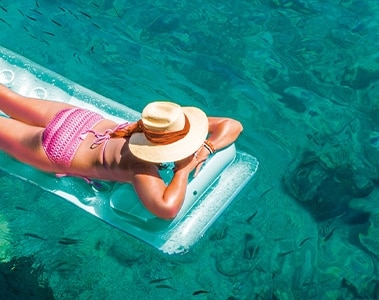
25 October 2022
Storiestest
June 23, 2022
The blog provides evidence on the environmental profile of Avobenzone and shows UV filter as a sustainable UV filter.
When it comes to sun protection products, people should not have to choose between protecting their health or the environment.
With our expertise and 40 years of work at the forefront of research in the UV industry, we have developed innovative, sustainable technologies that empower truly future-fit UV protection. It is our aim that consumers can be safe in the knowledge that their skin is protected without leaving a negative mark on the environment.
PARSOL® 1789 (Avobenzone) is the strongest and only globally approved UVA filter, aimed at protecting against skin-aging effects and UVA-induced skin cancer. Being the only UVA filter globally approved, its existence is vital to the formulation of effective sun protection products.
Based on this importance, combined with dsm-firmenich’s commitment to providing eco-friendly UV protection solutions, it was troubling when PARSOL® 1789 was deemed ‘not biodegradable’ according to OECD 302/ISO 11734 screening.
Here we explain why we explored additional evidence on the environmental fate of Avobenzone that provides support to the ingredient as a sun-safe and sustainable UV filter.
Although PARSOL® 1789 was deemed ‘not biodegradable’, the observations of Prof. Mitchelmore from the University of Maryland, Center of Environmental Science, reported little to no detection of Avobenzone at multiple locations, including very popular beaches, where other UV filters had been found1.
dsm-firmenich is a science driven company. Our aim is to shed light on controversial topics by providing factual information, in particular with regards to accuracy and relevance of scientific publications involving our products and knowledge expertises. Therefore, in attempt to explain this significant discrepancy, we have been working with industry peers to improve the quality of scientific data on the potential environmental impact of PARSOL® 1789.
What we have found is that the OECD result and guidelines do not take into account a key factor in the degradation of Avobenzone. This is because the relevant factor is not biological, for which the standard test is best suited. However, in reality there are many other potential degradation pathways.
When a compound is released to the environment, its fate does depend on the speed of metabolism by microbes, but also by abiotic processes – sunlight, for example, can provoke degradation. However, UV light is not typically part of the standard experimental set-up when scoring biodegradation.
UV radiation is present in virtually all locations where residual levels of UV filters have been found and where fauna and flora feed. For example, UV filters are introduced into surface waters and the marine environment directly by swimmers, or through wastewater streams. It can therefore be assumed that PARSOL® 1789 resides for a reasonably long time in shallow surface water, where it is exposed to solar UV radiation.
To predict the fate of Avobenzone in water, we needed to develop a modified test set-up. Typically, photo-stability investigations are done in solvent and high concentrations. To mimic the situation in surface waters we needed to create solutions of Avobenzone in water at lowest concentrations possible. It turned out to be that the solubility limit (around 1 ppm) is such a concentration, still allowing quantification of decay and being in a reasonable dilution range compared to sunscreens. PARSOL® 1789 was introduced into pure water at about 1.3 ppm and its stability was tested under UV radiation, using both an artificial source (Atlas Sun Test) and sunlight filtered through a standard glass window (to block UVB and weaken UVA).
Figure 1 shows the recovered concentration of Avobenzone as a percentage of the initial amount, dependent on the radiation source. The control, in which Avobenzone was kept in pure water in the dark for 2 days, showed a high recovery rate of 92.7%. Such high recovery needs to be expected when the biodegradation experiment is done according to OECD. However, when the sample was stored under window light for 2 days, 96% of the PARSOL® 1789 was lost. The same was observed if the sample received 25 MED (minimal erythemal dose) sun simulated irradiation in a testing device.

Fig. 1 | Recovery of Avobenzone in water with and without irradiation. Obtained by analytical evaluations (HPLC; % of initial amount).
These data show that Avobenzone degrades rapidly at low concentrations in water under artificial sun radiation, but even by sunlight through window glass, that filters UVB completely and weakens UVA. In both cases up to 96% of the compound were lost. It is worth noting that this is the limit of detection of the current analytical method. This proves that, while PARSOL® 1789 is not considered biodegradable according to OECD guidelines, the compound is degraded abiotically in the presence of UV light.
We performed similar setups also with sea water and found a comparable outcome. PARSOL® 1789 was also degraded in the same way even when an Avobenzone stabilizer like Octocrylene had been added to the sunscreen product to prevent photo-degradation, thanks to the separation of the two compounds upon dilution.
In conclusion, although PARSOL® 1789 is not classified as biodegradable according to OECD guidelines, the compound behaves as if it is largely biodegradable in the presence of UV light, in the absence of microorganisms and to the detection limit. This explains why little to none of the compound is observed in surface waters1.
Furthermore, these results indicate that PARSOL® 1789 has little chance to impact any organisms that dwell in near-surface waters. This is aligned with recent results from Registration, Evaluation, Authorization and Restriction of Chemicals (REACh) studies, which determined that:
As outlined above, the available evidence puts the deeming of PARSOL® 1789 as ‘not biodegradable’ according to OECD 302/ISO 11734 screening in perspective, and supports its use for the development of future-fit sun protection products that protect both people and the environment.
Hear more on UV protection and Sustainability within the Content Hub